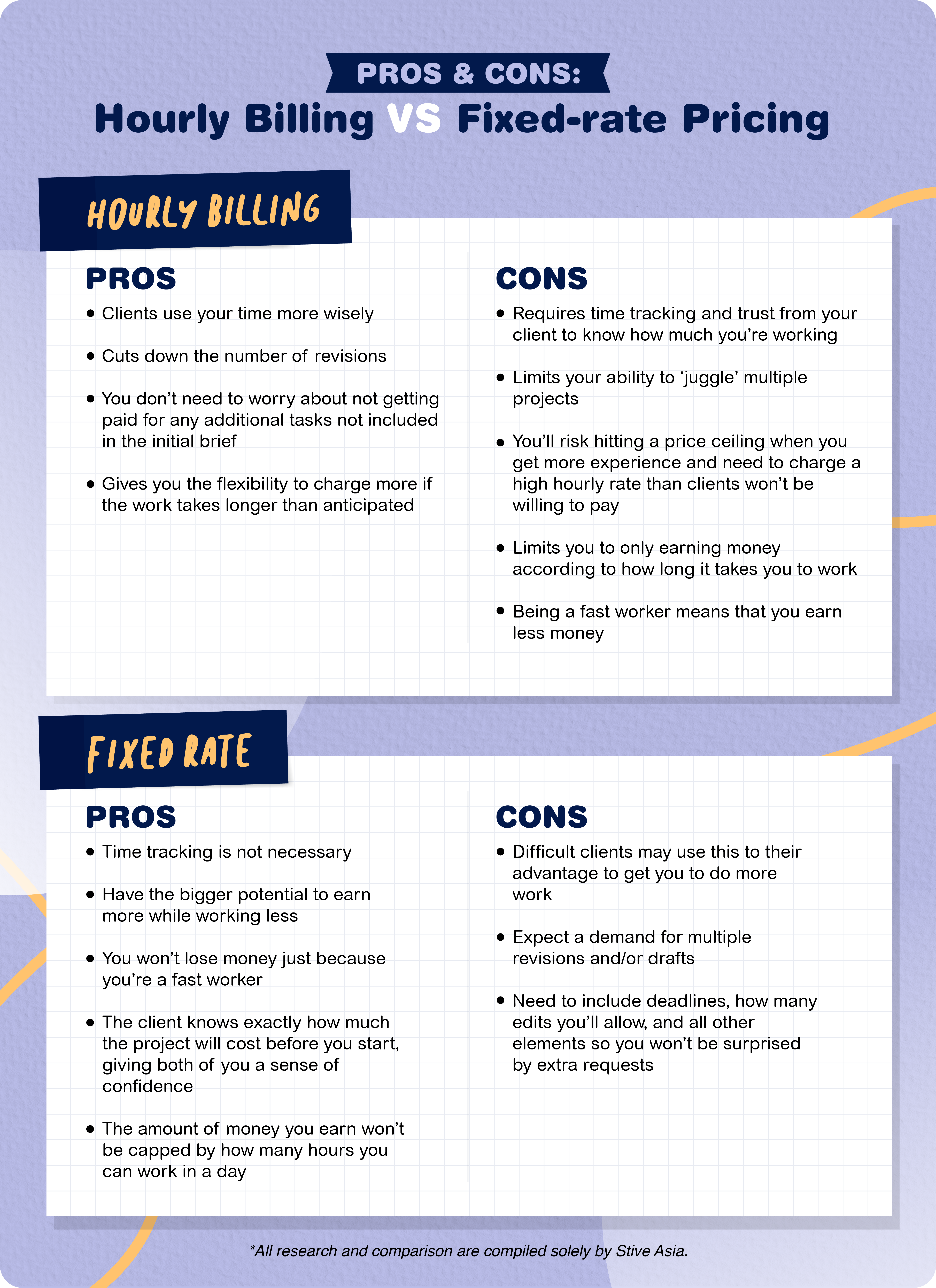Stive Asia
2021-09-13
When it comes to talking about money, many creative professionals tend to get uncomfortable. This dilemma brings about the most common dilemma every freelancer faces - how much should you charge for your freelance design work? It's always a tricky question to answer, especially if you're a newcomer and don't have any experience under your belt. Of course, we all want to get paid fairly, but how do we know what is fair?
We often believe that the work should speak for itself and assume cost correlates to the invested effort. However, things are not always this simple when it comes to billing your clients. There are a few factors that go into pricing yourself as a freelancer:
If you are a freelancer or aspire to become one and have always struggled with finding the most strategic answer to this question, then you are in the right place. In this article, we'll explore some different ways you can calculate a rate for your design work and help you find that perfect price point!

Before you start setting prices, it is good to figure out how much money you need to live off. First, track your monthly expenses so that you know how much money is enough for your needs. That includes things you DO and DON'T have to spend money on when you're working, like health insurance, computer (and software) equipment for work, time, electricity, etc.
With this, you'll know the absolute minimum price you can afford to charge your client. The minimum price model is a way to ensure that you won't lose money, and you can use it to find your break-even point.
A market rate is a fee that people in your profession charge. It is not what other people might charge for similar work or what you could get paid if you were working somewhere else. The market rates are usually expressed in a range, for example, RM50 to RM500 for a logo design. Why does this happen? This pricing reflects the second-factor point – levels of experience. Typically, a newcomer will be at the bottom of the rate list, and someone with 20 years' experience will be at the top.
Market rates are one way of pricing work, but one thing you should keep in mind when charging based on this:
"If the market rate is lower than the price you need to make, it will be hard for you. As a result, you may need to reduce expenses or learn better-paid skills."

Okay, so now you have a minimum goal set up and grasp how much you should be worth, let's talk about your options when setting a price for your work. We are going to talk about 2 different options:
This concept means you work according to an hourly rate, charging the client based on how many hours it takes for your services. This method would be an excellent option for newcomers to price themselves when you are just getting started and still unsure about the market. In that case, you don't need to worry when the client's scope increases or the project takes longer than expected because you will be compensated for the additional time that you work. You can also learn how fast you work without worrying about overestimating or underestimating yourself with hourly pricing. Besides, this also works ideally for open-ended jobs where the client isn't clear with what they want.
Fixed-rate pricing means that you quote a single price for the entire project - you are tying the project's price to how well it benefits your clients. This system works best when you're an experienced freelancer with high hourly rates or if your client knows that your service has excellent value and will only take up very little time from your schedule. The upside about the charging project is that it can very likely help you increase your income while working far less time.

Additional TIP to know: your client’s budget
How much should you expect a client is willing to pay? This question is a tricky one because, in most cases, the size of your client matters.
For example, let's say that two prospects come to you with similar needs for a project.
The first is Start-up A. He has an excellent project idea that you are passionate about, and he's easy to work with. Similarly, Corporate B has the same project quality and scope as Start-up A, but their budgets differ. For example, start-up A could only afford to pay you RM 3,500, whereas Corporate B is willing to pay you RM7,000. So then should you charge them the same?
“In truth, the short answer is NO.”
You might think it is right to charge Corporate B RM3,500 the same as Start-up A for the same project, but this would probably hurt you. In reality, pricing your work to align with the client's budget is a safe way of doing things. If you price along these lines, it will increase your income and chances of getting more projects.
We know your next question will be, "how do I know how much they can pay?"
You can find out by asking your client a series of questions listed here.

Whether to charge by project or hourly rate is ultimately up to you. Your living expenses must be tracked accurately and then adjusted accordingly for the best results. We would recommend keeping a fair and transparent price at all times and avoiding any negotiations as much as possible. At the end of the day, all your pricing set should complement the effort, passion and dedication you put in for your client. Don’t say YES to clients who don’t see your value.
“If you don’t learn the language of business, you may limit your growth and be relegated to the role of an order taker.” - Chris Do
Stay up to date with Stive Asia’s latest business and marketing advice for artists, designers and creators.
Facebook: https://www.facebook.com/StiveAsiaOfficial/
Instagram: https://www.instagram.com/stive.asia/?hl=en

Want to make money with graphic design? Learn how to start graphic design as a side hustle, the best tools to use, and tips to land your first clients.
03 March
Discover the top Malaysia doodle artists! Explore stunning creative designs and unique artwork from the best talents in the country. Get inspired today!
06 February
Wondering if print-on-demand is a profitable venture for artists? See the pros, cons, and tips for making money with print-on-demand services in this guide.
21 January
Discover what a digital designer does, including their key responsibilities, skills, and the impact they have. See how digital design shapes user experiences.
21 January
Discover the best personalized best friend gifts in Malaysia! Explore unique, thoughtful, and creative gift ideas to celebrate your friendship. Perfect for any occasion.
19 December
Discover the best online gift printing services to create personalized gifts for every occasion. High-quality prints, fast delivery, and unique customization options await!
10 December
Art prints on demand for artists and designers. Transform your artwork into custom prints with no upfront costs or inventory. Start selling globally today!
09 December